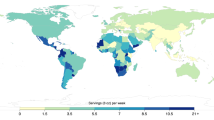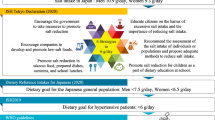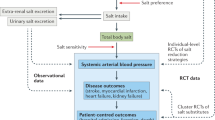Abstract
South Africa was among the first countries to adopt mandatory regulation in 2016 to lower the salt content in processed foods, aiming to reduce population salt intake to <5 g/day. To assess the effectiveness of this regulation in 20-30 year-old adults, we determined the change in salt intake over a mean follow-up time of 4.56-years spanning the implementation of the regulation. This observational study included baseline (2013–2016; N = 668; 24.9 ± 3 years; 47.8% black; 40.7% men) and follow-up data (2018—ongoing; N = 311; 25.4 ± 3.05 years; 51.1% black; 43.4% men) for participants of the African-PREDICT study. Salt intake was estimated from 24-h urinary sodium excretion. Median salt intake at baseline (N = 668) was 7.88 g/day (IQR: 5.67). In those followed (N = 311), salt intake reduced from baseline [median (IQR): 7.91 g/day (5.83)] to follow-up [7.26 g/day (5.30)] [unadjusted median: –0.82 g/day]. After adjusting for baseline salt intake to address regression to the mean, the mean salt reduction was –1.2 g/day. The greatest reductions were in men [mean difference: –1.47 g/day], black adults [mean difference: –2.04 g/day], and participants from low [mean difference: –1.89 g/day] or middle [mean difference: –1.84 g/day] socio-economic status groups, adjusting for baseline salt intake. Our preliminary findings suggest that South Africa’s salt regulation has been effective in lowering salt intake in young adults by ~1.2 g salt/day. Our study supports the effectiveness of upstream interventions to lower population salt intake, particularly for vulnerable groups who may typically consume more processed foods. It needs to be determined if the legislation has the anticipated population health gains.
This is a preview of subscription content, access via your institution
Access options
Subscribe to this journal
Receive 12 digital issues and online access to articles
$119.00 per year
only $9.92 per issue
Buy this article
- Purchase on Springer Link
- Instant access to full article PDF
Prices may be subject to local taxes which are calculated during checkout




Similar content being viewed by others
Data availability
Assignable to the informed consent given by participants, the data for this study, which is centrally managed by the data manger using REDCap, can be obtained by means of the necessary arrangements with Prof Aletta E Schutte or Prof Carina Mels from the Hypertension in Africa Research Team (HART). Potential collaborators are invited to contact the principal investigator of African-PREDICT for further information.
References
Vos T, Lim SS, Abbafati C, Abbas KM, Abbasi M, Abbasifard M, et al. Global burden of 369 diseases and injuries in 204 countries and territories, 1990-2019: a systematic analysis for the Global Burden of Disease Study 2019. Lancet. 2020;396:1204–22.
Afshin A, Sur PJ, Fay KA, Cornaby L, Ferrara G, Salama JS, et al. Health effects of dietary risks in 195 countries, 1990–2017: a systematic analysis for the Global Burden of Disease Study 2017. Lancet. 2019;393:1958–72.
World Health Organization. Guideline: Sodium intake for adults and children: World Health Organization; 2012.
Hyseni L, Green AE, Lloyd-Williams F, O’Flaherty M, Kypridemos C, McGill R, et al. Systematic review of dietary salt reduction policies: evidence for an “effectiveness hierarchy”? PLoSONE. 2016;12:e0177535.
Bertram MY, Steyn K, Wentzel-Viljoen E, Tollman S, Hofman KJ. Reducing the sodium content of high-salt foods: effect on cardiovascular disease in South Africa. S Afr Med J. 2012;102:743–5.
Watkins DA, Olson ZD, Verguet S, Nugent RA, Jamison DT. Cardiovascular disease and impoverishment averted due to a salt reduction policy in South Africa: an extended cost-effectiveness analysis. Health Policy Plan. 2015;31:75–82.
Neal B, Wu Y, Feng X, Zhang R, Zhang Y, Shi J, et al. Effect of salt substitution on cardiovascular events and death. N Eng J Med. 2021;385:1067–77.
Hofman KJ, RL Successful sodium regulation in South Africa. World Health Organization regional office for Africa; 2013.
Ware LJ, Charlton K, Schutte AE, Cockeran M, Naidoo N, Kowal P. Associations between dietary salt, potassium and blood pressure in South African adults: WHO SAGE Wave 2 Salt & Tobacco. Nutr Metab Cardiovasc Dis. 2017;27:784–91.
Elijovich F, Weinberger MH, Anderson CAM, Appel LJ, Bursztyn M, Cook NR, et al. Salt sensitivity of blood pressure. Hypertension. 2016;68:e7–e46.
Schutte A, Botha S, Fourie C, Gafane-Matemane L, Kruger R, Lammertyn L, et al. Recent advances in understanding hypertension development in sub-Saharan Africa. J Hum Hypertens. 2017;8:491–500.
Charlton KE, Steyn K, Levitt NS, Zulu JV, Jonathan D, Veldman FJ, et al. Diet and blood pressure in South Africa: Intake of foods containing sodium, potassium, calcium, and magnesium in three ethnic groups. Nutrition. 2005;21:39–50.
Charlton KE, Steyn K, Levitt NS, Zulu JV, Jonathan D, Veldman FJ, et al. Ethnic differences in intake and excretion of sodium, potassium, calcium and magnesium in South Africans. Eur J Cardiovasc Prev Rehabil. 2005;12:355–62.
Schutte AE, Gona PN, Delles C, Uys AS, Burger A, Mels CM, et al. The African Prospective study on the Early Detection and Identification of Cardiovascular disease and Hypertension (African-PREDICT): Design, recruitment and initial examination. Eur J Prev Cardiol. 2019;26:458–70.
Williams B, Mancia G, Spiering W, Agabiti Rosei E, Azizi M, Burnier M, et al. 2018 ESC/ESH Guidelines for the management of arterial hypertension: The Task Force for the management of arterial hypertension of the European Society of Cardiology (ESC) and the European Society of Hypertension (ESH). Eur Heart J. 2018;39:3021–104.
WHO/PAHO Regional Expert Group for Cardiovascular Disease Prevention through Population‐wide Dietary Salt Reduction. Protocol for population level sodium determination in 24‐hour urine samples. World Health Organization Geneva, Switzerland; 2010.
Stolarz-Skrzypek K, Kuznetsova T, Thijs L, et al. FAtal and nonfatal outcomes, incidence of hypertension, and blood pressure changes in relation to urinary sodium excretion. JAMA. 2011;305:1777–85.
Center for Disease Control and Prevention. Sodium reduction toolkit: a global opportunity to reduce population-level sodium intake. 2013. [Available from: http://medbox.iiab.me/modules/en-cdc/www.cdc.gov/salt/sodium_toolkit.htm.1]
Stevens LA, Claybon MA, Schmid CH, Chen J, Horio M, Imai E, et al. Evaluation of the Chronic Kidney Disease Epidemiology Collaboration equation for estimating the glomerular filtration rate in multiple ethnicities. Kidney Int. 2011;79:555–62.
Schultz WM, Kelli HM, Lisko JC, Varghese T, Shen J, Sandesara P, et al. Socioeconomic status and cardiovascular outcomes. Circulation. 2018;137:2166–78.
World Health Organization. Global action plan for the prevention and control of noncommunicable diseases 2013-20. 2013.
Swanepoel B, Malan L, Myburgh PH, Schutte AE, Steyn K, Wentzel-Viljoen E. Sodium content of foodstuffs included in the sodium reduction regulation of South Africa. J Food Composit Anal. 2017;63:73–8.
Charlton KE, Corso B, Ware L, Schutte AE, Wepener L, Minicuci N, et al. Effect of South Africa’ s interim mandatory salt reduction programme on urinary sodium excretion and blood pressure. Prev Med Rep. 2021;23:101469. https://doi.org/10.1016/j.pmedr.2021.101469.
Tekle DY, Santos JA, Trieu K, Thout SR, Ndanuko R, Charlton K, et al. Monitoring and implementation of salt reduction initiatives in Africa: a systematic review. J Clin Hypertens. 2020;22:1355–70.
Menyanu E, Charlton KE, Ware LJ, Russell J, Biritwum R, Kowal P. Salt use behaviours of ghanaians and south africans: a comparative study of knowledge, attitudes and practices. Nutrients. 2017;9:939.
Capewell S, Kypridemos C. Socioeconomic inequalities in dietary sodium intake: upstream versus downstream interventions. Am J Public Health. 2017;107:499–500.
The Heart and Stroke Foundation SA. ENDORSEMENTS [Available from: https://www.heartfoundation.co.za/endorsements/].
Wentzel-Viljoen E, Steyn K, Lombard C, De Villiers A, Charlton K, Frielinghaus S, et al. Evaluation of a mass-media campaign to increase the awareness of the need to reduce discretionary salt use in the South African population. Nutrients. 2017;9. https://doi.org/10.3390/nu9111238
Campbell NR, He FJ, Tan M, Cappuccio FP, Neal B, Woodward M, et al. The International Consortium for Quality Research on Dietary Sodium/Salt (TRUE) position statement on the use of 24‐hour, spot, and short duration (< 24 h) timed urine collections to assess dietary sodium intake. J Clin Hypertens. 2019;21:700–9.
Charlton KE, Schutte AE, Wepener L, Corso B, Kowal P, Ware LJ. Correcting for Intra-individual variability in sodium excretion in spot urine samples does not improve the ability to predict 24 h urinary sodium excretion. Nutrients. 2020;12:2026.
Acknowledgements
We are grateful towards all individuals participating voluntarily in the study. The dedication of the support and research staff as well as students at the Hypertension Research and Training Clinic at the North-West University are also duly acknowledged.
Funding
The research funded in this manuscript is part of an ongoing larger research project financially supported by the South African Medical Research Council (SAMRC) with funds from National Treasury under its Economic Competitiveness and Support Package; the South African Research Chairs Initiative (SARChI) of the Department of Science and Technology and National Research Foundation (NRF) of South Africa (GUN 86895); SAMRC with funds received from the South African National Department of Health, GlaxoSmithKline R&D (Africa Non-Communicable Disease Open Lab grant), the UK Medical Research Council and with funds from the UK Government’s Newton Fund; as well as corporate social investment grants from Pfizer (South Africa), Boehringer-Ingelheim (South Africa), Novartis (South Africa), the Medi Clinic Hospital Group (South Africa) and in-kind contributions of Roche Diagnostics (South Africa). Any opinion, findings, and conclusions or recommendations expressed in this material are those of the authors, and therefore, the NRF does not accept any liability in this regard.
Author information
Authors and Affiliations
Contributions
AES and MSK conceived and/designed the work that led to the submission. MSK, AES, EWV, LJW an TVZ acquired the data. AES, MSK, EWV, LJW, TVZ, KC and SE helped with the interpretation of the results. MSK drafted the first version of the manuscript and AES, EWV, LJW, TVZ, KC and SE critically revised the manuscript. All authors MSK, AES, EWV, LJW, TVZ, KC and SE approved the final version of the manuscript and agree to be accountable for all aspects of the work.
Corresponding author
Ethics declarations
Competing interests
The authors declare no competing interests.
Additional information
Publisher’s note Springer Nature remains neutral with regard to jurisdictional claims in published maps and institutional affiliations.
Supplementary information
Rights and permissions
About this article
Cite this article
Strauss-Kruger, M., Wentzel-Viljoen, E., Ware, L.J. et al. Early evidence for the effectiveness of South Africa’s legislation on salt restriction in foods: the African-PREDICT study. J Hum Hypertens 37, 42–49 (2023). https://doi.org/10.1038/s41371-021-00653-x
Received:
Revised:
Accepted:
Published:
Issue Date:
DOI: https://doi.org/10.1038/s41371-021-00653-x



